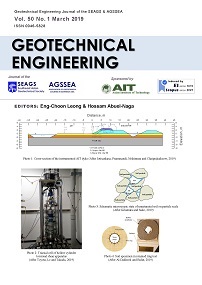Simplified Model for Heat Transfer in Unsaturated Soils Considering a Nonisothermal Thermal Conductivity Function
Main Article Content
Abstract
Heat transfer in unsaturated soils occurs primarily due to conduction, convection of pore fluids in both liquid and vapor forms, and latent heat transfer. Due to the complexity involved in simulating this coupled problem, this paper investigates a simplified model for heat transfer in unsaturated soils using a conduction analysis with a nonisothermal thermal conductivity function. Specifically, a relationship between the apparent thermal conductivity and degree of saturation that indirectly incorporates the effects of heat transfer due to convection and water phase change through temperature effects was defined based on experimental observations, and the governing equation for conductive heat transfer was reconsidered to account for the variation in nonisothermal thermal conductivity with respect to space and time. An axisymmetric analysis for horizontal heat transfer in a soil layer from a line heat source was performed using the simplified heat transfer model, and results were compared with a conventional isothermal conduction analysis. Further, a comparison of simulated soil temperatures from the simplified heat transfer model with measured temperatures from an experimental study on heat transfer in unsaturated silt shows a good match, indicating that the simplified model may be used for preliminary analyses of problems involving monotonic heating.
Article Details

This work is licensed under a Creative Commons Attribution-NonCommercial-NoDerivatives 4.0 International License.
Copyright © 2019 Association of Geotechnical Societies in Southeast Asia (AGSSEA) - Southeast Asian Geotechnical Society (SEAGS).


